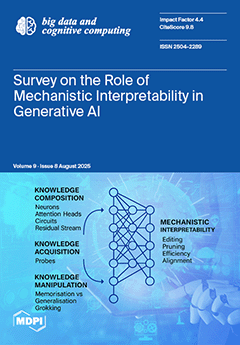The rapid advancement of artificial intelligence (AI) and machine learning has revolutionised how systems process information, make decisions, and adapt to dynamic environments. AI-driven approaches have significantly enhanced efficiency and problem-solving capabilities across various domains, from automated decision-making to knowledge representation and predictive
[...] Read more.
The rapid advancement of artificial intelligence (AI) and machine learning has revolutionised how systems process information, make decisions, and adapt to dynamic environments. AI-driven approaches have significantly enhanced efficiency and problem-solving capabilities across various domains, from automated decision-making to knowledge representation and predictive modelling. These developments have led to the emergence of increasingly sophisticated models capable of learning patterns, reasoning over complex data structures, and generalising across tasks. As AI systems become more deeply integrated into networked infrastructures and the Internet of Things (IoT), their ability to process and interpret data in real-time is essential for optimising intelligent communication networks, distributed decision making, and autonomous IoT systems. However, despite these achievements, the internal mechanisms that drive LLMs’ reasoning and generalisation capabilities remain largely unexplored. This lack of transparency, compounded by challenges such as hallucinations, adversarial perturbations, and misaligned human expectations, raises concerns about their safe and beneficial deployment. Understanding the underlying principles governing AI models is crucial for their integration into intelligent network systems, automated decision-making processes, and secure digital infrastructures. This paper provides a comprehensive analysis of explainability approaches aimed at uncovering the fundamental mechanisms of LLMs. We investigate the strategic components contributing to their generalisation abilities, focusing on methods to quantify acquired knowledge and assess its representation within model parameters. Specifically, we examine mechanistic interpretability, probing techniques, and representation engineering as tools to decipher how knowledge is structured, encoded, and retrieved in AI systems. Furthermore, by adopting a mechanistic perspective, we analyse emergent phenomena within training dynamics, particularly memorisation and generalisation, which also play a crucial role in broader AI-driven systems, including adaptive network intelligence, edge computing, and real-time decision-making architectures. Understanding these principles is crucial for bridging the gap between black-box AI models and practical, explainable AI applications, thereby ensuring trust, robustness, and efficiency in language-based and general AI systems.
Full article





